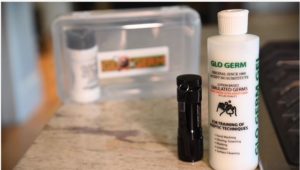Handwashing may not actually qualify as a fine art, but it is one of the best ways to protect yourself and your family from getting sick. Andrew Donovan, RN – St. Joe’s Infection Preventionist spends his days thinking about and acting on infection prevention. The recent return to school is an opportunity to remind our community about the importance of proper hand hygiene, especially as we continue to work together to slow the spread of COVID-19.
Andrew recently met up with fourth grader, Ally, to demonstrate the way germs can stick to your hands  and where they like to hide. Handwashing is one of the best ways to protect yourself and your family from getting sick.
and where they like to hide. Handwashing is one of the best ways to protect yourself and your family from getting sick.
Andrew and Ally applied a gel to Ally’s hands that glows under a black light. The glowing gel represents where germs tend to hide on your hands. This demonstration helped us to understand how important each handwashing step is and where germs like to hide. Check in out in our video below:
Important Handwashing Facts:
Washing hands can keep you healthy and prevent the spread of respiratory and diarrheal infections from one person to the next. Germs can spread from other people or surfaces when you:
- Touch your eyes, nose, and mouth with unwashed hands
- Prepare or eat food and drinks with unwashed hands
- Touch a contaminated surface or objects
- Blow your nose, cough, or sneeze into hands and then touch other people’s hands or common objects
When to wash your hands:
You can help yourself and your loved ones stay healthy by washing your hands often, especially during  these key times when you are likely to get and spread germs:
these key times when you are likely to get and spread germs:
- Before, during, and after preparing food
- Before eating food
- Before and after caring for someone at home who is sick with vomiting or diarrhea
- Before and after treating a cut or wound
- After using the toilet
- After changing diapers or cleaning up a child who has used the toilet
- After blowing your nose, coughing, or sneezing
- After touching an animal, animal feed, or animal waste
- After handling pet food or pet treats
- After touching garbage
During the COVID-19 pandemic, you should also clean hands:
- After you have been in a public place and touched an item or surface that may be frequently touched by other people, such as door handles, tables, gas pumps, shopping carts, or electronic cashier registers/screens, etc.
- Before touching your eyes, nose, or mouth because that’s how germs enter our bodies.
Follow Five Steps to Wash Your Hands the Right Way
Washing your hands is easy, and it’s one of the most effective ways to prevent the spread of germs. Clean hands can stop germs from spreading from one person to another and throughout an entire community—from your home and workplace to childcare facilities and hospitals.
Five Steps to Clean Hands:
- Wet your hands with clean, running warm water, not too hot.
- Lather your hands by rubbing them together with liquid soap. Make sure to lather the backs of your hands, between your fingers, and under your nails.
- Scrub your hands for at least 20 seconds. Need a timer? Sing the ABC’s or Happy birthday twice (we’ve also heard that Journey’s “Don’t Stop Believin’” chorus is a good substitute).
- Rinse your hands well under clean, running water.
- Dry your hands using a clean towel, use towel to turn off faucet. When drying, wipe from finger tips down to wrist to avoid reintroducing germs to your hands.
What you need to know about hand sanitizer:
Washing hands with soap and water is the best way to get rid of germs in most situations. If soap and water are not readily available, you can use an alcohol-based hand sanitizer that contains at least 60% alcohol – check your label.
Sanitizers can quickly reduce the number of germs on hands in many situations.
- Sanitizers do not get rid of all types of germs.
- Hand sanitizers may not be as effective when hands are visibly dirty or greasy.
- Hand sanitizers might not remove harmful chemicals from hands like pesticides and heavy metals.
Caution! Swallowing alcohol-based hand sanitizers can cause alcohol poisoning if more than a couple of mouthfuls are swallowed. Keep it out of reach of young children and supervise their use.
How to use hand sanitizer:
- Apply the gel product to the palm of one hand (read the label to learn the correct amount).

- Rub your hands together.
- Rub the gel over all the surfaces of your hands and fingers until your hands are dry. This should take around 20 seconds.
This blog was sourced by information obtained through the CDC’s Life is Better with Clean Hands campaign encourages adults to make handwashing part of their everyday life and encourages parents to wash their hands to set a good example for their kids. Visit the Life is Better with Clean Hands campaign page to download resources to help promote handwashing in your community.
For more information on handwashing, visit CDC’s Handwashing website or call 1-800-CDC-INFO.
